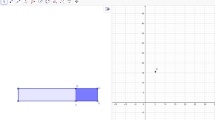Abstract
In this paper we analyse to what extent the computational model of the geometry implemented in a dynamic geometry environment provides models for physical motion, focusing on the continuity issues related to motion. In particular, we go over the utility of dynamic geometry environments to simulate the motion of mechanical linkages, as this activity allows us to compare, by means of dynamic drawings, the computable representation of geometric properties with the real motion of a mechanism. Analysing a simple example, we provide theoretical foundations for particular behaviours observed in the motion of a picture on the screen, which require a subtle interpretation to be understood in a purely physical context. In this way, we reflect on some requirements imposed by the computable representation of knowledge. We consider this work to be a necessary step to determine didactic consequences related to students' perceptions of the moving displays; in particular those concerning the uses of the dragging mode as a tool not only for automatic drawing of many instances of a construction,but also to produce continuous motion.
Similar content being viewed by others
REFERENCES
Baker, D. (1990). Some topological problems in robotics. The Mathematical Intelligencer 12(1): 66-76.
Balacheff, N. (1994). Didactique et intelligence artificielle. Recherches en Didactique des Mathematiques 14(1.2): 9-42.
Freudenthal, H. (1983). Didactical Phenomenology of Mathematical Structures. Dordrecht: Reidel Pub. Co.
Goldenberg, E.P. and Cuoco, A.A. (1998). What is dynamic geometry? In R. Lehrer and D. Chazan (Eds), Designing Learning Environments for Developing Understanding of Geometry and Space (pp. 351-367). Lawrence Erlbaum Assoc.
Hölzl, R. (1996). How does dragging affect the learning of geometry. Int. Journal of Computers for Mathematical Learning 1: 169-187.
Laborde, J.M. (1997). Exploring non-euclidean geometry in a dynamic geometry environment like Cabri-Géomètre. In James King and Doris Schattschneider (Eds), Geometry Turned on (pp. 185-191). MAA Notes, N. 41. The Mathematical Association of America.
Laborde, C. (1998). Visual phenomena in the teaching/learning of geometry in a computer-based environment. In C. Mammana. and V. Villani (Eds), Perspectives on the Teaching of Geometry for the 21st Century (pp. 113-121). Dordrecht: Kluwer Academic Publishers.
Laborde, J.M. (1999). Some issues raised by the development of implemented Dynamic Geometry as with Cabri-géomètre. Proceedings 15th European Workshop on Computational Geometry (pp. 7-19). H. Brönnimann Ed. INRIA Sophia Antipolis.
Laborde, J.M. and Straesser, R. (1990). Cabri-Géomètre: A micro-world of geometry for guided discovery learning. Zentralblatt fur didaktik der mathematik 5: 171-190.
Richter-Gebert, J. and Kortenkamp, U. (1999). Cinderella-The Interactive Geometry Software. Berlin: Springer Verlag.
Author information
Authors and Affiliations
Rights and permissions
About this article
Cite this article
González-López, M.J. Using Dynamic Geometry Software to Simulate Physical Motion. International Journal of Computers for Mathematical Learning 6, 127–142 (2001). https://doi.org/10.1023/A:1017982418841
Issue Date:
DOI: https://doi.org/10.1023/A:1017982418841




